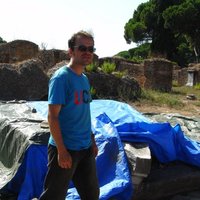Michael Mulryan
University of Kent, Classical and Archaeological Studies, Department Member
- Eberhard Karls Universität Tübingen, History, Department Memberadd
- Late Antique Archaeology, Urban Anthropology, Late Antiquity, Urban Studies, Urban History, Urban Geography, and 24 moreTopography of Ancient Rome (Archaeology), Ancient Topography (Archaeology), Ostia (Archaeology), Ancient Religion, Archaeology of Religion, Archaeology, Ostia Antica, Early Christian Archaeology, Constantinople, Roman Temples, Roman Religion, Early Medieval Archaeology, Late Roman Archaeology, Roman History, Roman Archaeology, Late Antique Art and Archaeology, Ancient Rome, Early Christianity, Byzantine Studies, Byzantine Archaeology, Rome, City of, Late Antique and Byzantine History, Late Antique and Byzantine Studies, and Early Medieval Historyedit
- Assistant Director of Kent 'Late Antique Ostia Project' Honorary Research Fellow - Centre for Late Antique Archaeolog... moreAssistant Director of Kent 'Late Antique Ostia Project'
Honorary Research Fellow - Centre for Late Antique Archaeology, University of Kent
Associate Researcher - École Normale Supérieure, Paris
Former DFG Research Fellow - Migration and Mobility, University of Tuebingenedit
Research Interests: Urban Geography, Space and Place, Urban History, Late Antique Archaeology, Early Christianity, and 17 moreUrban Studies, Byzantine Studies, Late Antiquity, Paganism, Ostia (Archaeology), Topography of Ancient Rome (Archaeology), Ancient construction (Archaeology), Ancient Topography (Archaeology), Public Space, Ancient Urbanism, Ancient Architecture and Construction History, Ostia Antica, Streets, Housing, ancient, Fountains and Nymphaea, Ancient Public Architecture, and Shops
This book is the first to closely examine the location of the earliest purpose-built Christian buildings inside the city of Rome in their contemporary context. It argues that some of these were deliberately sited by their builders so as... more
This book is the first to closely examine the location of the earliest purpose-built Christian buildings inside the city of Rome in their contemporary context. It argues that some of these were deliberately sited by their builders so as to utilise prominent positions within the urban landscape or to pragmatically reuse pre-existing bath facilities for Christian liturgical practice. Several examples are discussed with the latest archaeological discoveries explored. Two particular case studies are also examined within the Subura area of the city, and their urban location is examined in relation to the commercial, religious, social and public spaces around them, known through a 3rd century A.D. survey of the city. Certain other Christian basilicas in the city encroached or blocked roads, were situated by main arterial highways, were located on hills and eventually reused prestigious public buildings. Other examples were located by potent ‘pagan’ sites or important places of public congregation, with two structures suggesting the political astuteness of a 4th century pope. This book shows that the spatial Christianisation of Rome was not a random and haphazard process, but did at times involve projects that strategically built new Christian centres in places that would visually or practically enhance what were generally small and modest structures.
Research Interests:
Research Interests:
A micro examination of a region of Ostia in late antiquity. Paths of movement, accessibility, and how the road space was used and interacts with the buildings off it, are the foci of the study. This analysis gives us some insights into... more
A micro examination of a region of Ostia in late antiquity. Paths of movement, accessibility, and how the road space was used and interacts with the buildings off it, are the foci of the study. This analysis gives us some insights into the spatial 'working' of late antique Ostia as a whole.
Research Interests:
Research Interests:
Research Interests:
This article argues that from about the 7th century A.D. a narrative-driven itinerary was created within the streets of Rome to allow individuals to follow in the footsteps of the popular martyr deacon Lawrence. Three Christian centres... more
This article argues that from about the 7th century A.D. a narrative-driven itinerary was created within the streets of Rome to allow individuals to follow in the footsteps of the popular martyr deacon Lawrence. Three Christian centres were founded at about this time (with a fourth a few centuries later) that laid claim to be built on the site of important places in the recently canonised passion of Lawrence, sites that led up to and marked the place of his death. There are no real comparable narrative-driven devotional itineraries for holy men, heroes or deities in the pre-Christian Classical world, with only Remus in Rome coming close, so this seems to be a Christian innovation.
Key words: Rome, Lawrence, Martyrdom, churches, Hercules, Remus, nodes, paths.
Key words: Rome, Lawrence, Martyrdom, churches, Hercules, Remus, nodes, paths.
Research Interests:
This paper looks at one form of 'Christianisation': spatial Christianisation, and its impact. It does this by focusing on two 'ordinary' Christian buildings constructed within a typical neighbourhood in the city of Rome, and discusses the... more
This paper looks at one form of 'Christianisation': spatial Christianisation, and its impact. It does this by focusing on two 'ordinary' Christian buildings constructed within a typical neighbourhood in the city of Rome, and discusses the roads, monuments and buildings around it.
